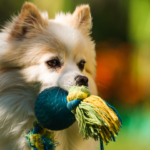Are you struggling to train your stubborn Pomeranian? Don’t despair – it can be done! With the right combination of positive reinforcement, patience, and rewards, you can teach your pup the skills you need.
Read on to learn winning tactics for training a stubborn Pomeranian, and see how much progress you can make!
Key Takeaways
- Positive reinforcement and rewards are key for training a stubborn Pomeranian.
- Break up training into manageable chunks and keep sessions short and engaging.
- Understanding your Pomeranian’s body language is crucial for successful training.
- Create a distraction-free training environment and provide safety and security through understanding their body language.
Positive Reinforcement
When it comes to training a stubborn Pomeranian, positive reinforcement is key! Pomeranians are highly intelligent and can be a joy to train when the correct approach is used. Positive reinforcement is the act of rewarding desired behavior with treats, verbal praise, and petting. When using this technique, always ensure that the reward is given immediately after the desired behavior. This lets the Pomeranian know exactly what behavior is being rewarded.
Creating a reward system is a great way to motivate your Pomeranian. Start with small tasks and use a combination of treats, verbal praise, and petting. As your Pomeranian progresses, gradually increase the difficulty of the tasks. Keep your praise words consistent and positive. This reinforces the desired behavior and makes your Pomeranian more likely to repeat it in the future.
Positive reinforcement is a powerful tool for training a stubborn Pomeranian. When used correctly, it can help your furry friend learn desired behaviors quickly and efficiently. Remember to be consistent and use consistent praise words to ensure success!
Short and Fun Sessions
Training a stubborn Pomeranian can be a challenge. However, short and fun sessions are key. Break up the training into manageable chunks. Reward progress along the way. Repetition is also important. It helps to reinforce the behavior you’re looking to achieve.
Rewarding Progress
Rewarding your Pomeranian’s progress with short and fun training sessions can help you achieve success. Using positive reinforcement techniques, such as treats, verbal praise, and petting, can help build a trusting bond between you and your pup. Consistency is key, and it’s important to reward your little one when they do something right.
By providing them with positive reinforcement, you’re also helping reinforce the behavior you want to see. Through repetition, your Pomeranian will learn the desired behavior and be more likely to follow your commands. As you progress in training, you’ll begin to see the benefits of repetition as your pup masters the task at hand.
Moving forward, be sure to continue incorporating short and fun training sessions to build on the progress you’ve made.
Repetition Benefits
By consistently engaging in short and fun sessions, you’ll begin to reap the benefits of repetition in Pomeranian training. This kind of approach is a great way to help your pup adjust to new socializing cues, while also bonding with you through activities.
While it may be tempting to give up when your pup is uncooperative, remaining consistent in the approach will serve you both in the long run. Consistent repetition helps your pup learn what’s expected of them while also creating trust in your relationship.
Make sure to keep the sessions short to avoid overwhelming your pup, and make sure to incorporate plenty of positive reinforcement. With enough patience and consistency, you’ll be able to establish a strong bond with your pup and create a strong foundation for future training.
Patience and Consistency
With patience and consistency, you’ll be able to successfully train your Pomeranian. Effective communication and a proactive approach are key to making this possible. Here are three key steps to help you along the way:
- Be firm yet gentle.
- Set and reinforce boundaries.
- Utilize positive reinforcement.
Demonstrating patience and consistency in your approach will help your Pomeranian understand what’s expected of them, and how to achieve it. By taking a compassionate, yet firm stance, you’ll be able to establish a relationship based on mutual respect that will serve both of you well.
Focus on effective communication and a proactive approach to ensure success in your training. Afterwards, reward your Pomeranian with high value rewards to reinforce the desired behavior.
High Value Rewards
By providing your Pomeranian with high value rewards, you’ll be able to reinforce the desired behavior and reduce stress. High value rewards, such as treats, toys, and verbal praise, can be used to encourage play and build a trusting relationship between you and your pet.
Start by using smaller rewards for minor successes, and save the bigger rewards for more complex tasks. As your pet progresses, you can gradually reduce the rewards until they become accustomed to the new routine.
Make sure to keep the rewards exciting and engaging by changing up the types of rewards you offer. This will help keep your pup’s interest piqued and show them that good behavior is worth the effort.
When possible, provide your Pomeranian with rewards immediately after the desired behavior is exhibited. This will help them make the connection and learn faster.
With patience and high value rewards, you can successfully train even the most stubborn Pomeranian.
Distraction-Free Environment
Creating a distraction-free environment for your Pomeranian is key for successful training. This includes setting up a space free from distractions such as other animals, people, and outside noise. Providing your pup with plenty of stimulation is also important.
To ensure a successful training session, it’s important to use reward-based training methods. This means reinforcing positive behavior with treats, praise, or play. Reward-based training is effective because it motivates your Pomeranian to repeat the desired behavior.
In addition to training, socialization is crucial for your Pomeranian’s development. This involves exposing them to different people, animals, and environments. Socialization helps your pup become comfortable and well-behaved in various situations.
Simple Commands
Once you’ve created a distraction-free environment and reinforced positive behavior, it’s time to start teaching your Pomeranian some simple commands.
Socializing skills can be taught through repetition and reward systems. Use your voice to direct simple commands such as ‘sit’, ‘stay’, and ‘come’.
Begin with basic commands and then gradually move to more complex tasks. Speak in a clear and firm voice that’s concise and consistent.
Use a reward system to motivate the pup, such as treats or verbal praise. Remember to keep the sessions short, as a Pomeranian’s attention span can be limited.
By providing a positive and consistent approach, your Pomeranian will learn quickly. End each session on a positive note and you’ll be well on your way to having a well-trained pup.
With these simple commands in place, you can now move to the next section to learn how to avoid punishment.
Avoid Punishment
You can avoid punishment by not punishing your Pomeranian. Instead, focus on reinforcement techniques such as positive reinforcement, reward-based training, and problem solving. When you focus on positive ways to shape your dog’s behavior, you’ll be far more successful in the long run.
Here are some key points to remember when training your Pomeranian:
- Praise and reward behaviors you like
- Redirect misbehavior in a positive way
- Remain consistent with your approach
Your Pomeranian will pick up on your body language and responses, so it’s important to stay calm and patient. Stay positive and look for ways to reward good behavior. This will help your Pomeranian understand what’s expected of them and feel more secure.
With the right guidance and reinforcement techniques, you can help your Pomeranian become a well-behaved companion. As you move forward, keep in mind the importance of body language in the training process.
Body Language
Understanding your Pomeranian’s body language is key to successful training. Pay attention to your pup’s posture signals and make sure to maintain eye contact with them.
This will help you create a healthy bond of trust and respect with your pup.
Posture Signals
By recognizing the posture signals your Pomeranian is giving, you can gain a better understanding of their needs. Here are some tips to help you do just that:
- Correcting posture and body language when reacting to your pup.
- Interpreting signals through body language and vocalization.
- Developing an understanding of your pup’s individual preferences.
Learning your pup’s body language is essential to developing a strong relationship. When you can recognize their signals, you can address their needs and help them build confidence. Start by paying attention to their posture in various situations. Are they standing tall or cowering? Are they barking or wagging their tail?
Being aware of these signals can allow you to better understand their behavior and help you become a more effective trainer.
With patience and practice you can become a pro at recognizing posture signals. Your pup depends on you for safety and security, and by understanding their body language you’ll be able to provide both.
Eye Contact
You’ll also want to pay attention to your pup’s eye contact when you’re training; it can tell you a lot about how they’re feeling. When they look away, it could indicate that they’re feeling overwhelmed. To redirect their focus, provide them with a reward or a command.
If your pup maintains steady eye contact, it could mean they’re feeling confident. This is a great time to reinforce rules and commands. It’s important to be patient and consistent with your Pomeranian while training. Make sure to keep a positive attitude and reward them for good behavior.
Eye contact is a powerful tool to help you understand and support your pup’s training journey.
Frequently Asked Questions
What Is the Best Age to Begin Training a Pomeranian?
Start training your Pomeranian as early as possible, with patience and consistency. Crate training helps them get used to their environment and builds trust. Be compassionate as you guide them through the process, and you’ll be rewarded with a loyal companion.
How Can I Tell if My Pomeranian Is Ready to Learn?
Observe your Pomeranian’s behavior. If he responds positively to positive reinforcement and reward systems, he is likely ready to learn. Show him patience and kindness to help him feel comfortable and willing to learn. Encourage good behavior with praise and rewards.
What if My Pomeranian Is Too Aggressive for Positive Reinforcement?
If your Pomeranian is too aggressive for positive reinforcement, try redirection techniques and behavioral management. With patience and understanding, you can help them learn appropriate behavior and lead a happier life.
What Are the Most Effective Rewards for My Pomeranian?
When training a Pomeranian, treats and verbal praise are often the most effective rewards. Toys and physical affection can also be used, but usually do not have as much of an impact. Focus on what your pup loves and use that to encourage positive behavior.
How Do I Know if My Pomeranian Is Responding to the Training?
You’ll know your pup is responding to the training when they begin to socialize better and become more comfortable with crate training. Observe their behavior and look for signs of progress. Be patient and compassionate—you’ve got this!
Conclusion
Training a stubborn Pomeranian can be challenging, but with patience, consistency, and positive reinforcement, you can help your pup learn in no time.
Keep sessions short and fun, use high-value rewards, and avoid punishment. Remember to use simple commands and pay attention to your body language.
With a bit of effort, you’ll have a well-behaved Pomeranian in no time.
Good luck!






